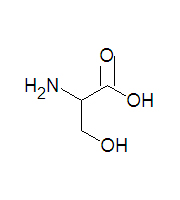Serine: Difference between revisions
Jump to navigation
Jump to search

imported>David E. Volk (stub and structure) |
imported>David E. Volk (fixed error) |
||
| Line 2: | Line 2: | ||
[[Image:Serine stickfigure DEVolk.jpg|right|thumb|350px|{{#ifexist:Template:Serine stickfigure DEVolk.jpg/credit|{{Serine stickfigure DEVolk.jpg/credit}}<br/>|}}'''Serine''', one of the twenty common amino acids.]] | [[Image:Serine stickfigure DEVolk.jpg|right|thumb|350px|{{#ifexist:Template:Serine stickfigure DEVolk.jpg/credit|{{Serine stickfigure DEVolk.jpg/credit}}<br/>|}}'''Serine''', one of the twenty common amino acids.]] | ||
'''Serine''', abbreviated as '''Ser''' or '''S''', is one of the twenty common [[amino acid]]s used by living organisms to build [[protein]]s. It is one of the smallest amino acids, being larger than only [[glycine]] and [[alanine]]. It is subject to [[phosphorylation]] by [[kinase]]s because it is one of the three amino acids, together with [[threonine]] and [[tyrosine]], that contain a [[hydroxyl]] group (OH) on the side chain. It | '''Serine''', abbreviated as '''Ser''' or '''S''', is one of the twenty common [[amino acid]]s used by living organisms to build [[protein]]s. It is one of the smallest amino acids, being larger than only [[glycine]] and [[alanine]]. It is subject to [[phosphorylation]] by [[kinase]]s because it is one of the three amino acids, together with [[threonine]] and [[tyrosine]], that contain a [[hydroxyl]] group (OH) on the side chain. It can be thought of as a hydroxylated [[alanine]]. | ||
Revision as of 15:02, 17 January 2008
Serine, abbreviated as Ser or S, is one of the twenty common amino acids used by living organisms to build proteins. It is one of the smallest amino acids, being larger than only glycine and alanine. It is subject to phosphorylation by kinases because it is one of the three amino acids, together with threonine and tyrosine, that contain a hydroxyl group (OH) on the side chain. It can be thought of as a hydroxylated alanine.
